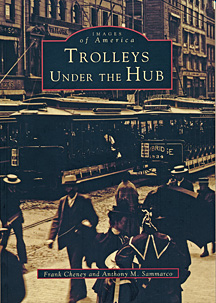Select Books About New England Railroad History
If you can't visit Bedford Freight House to see our wide selection of railroad history books, ordering online is the next best thing!
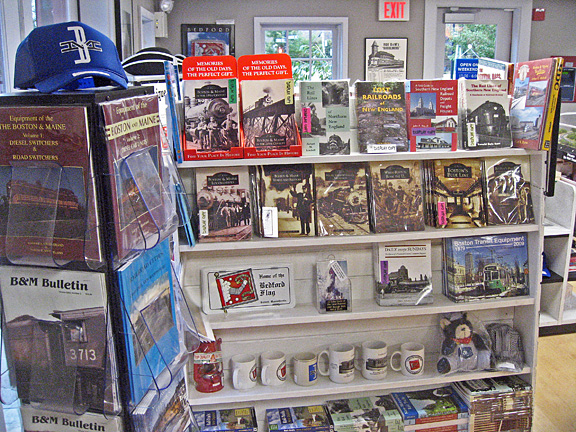
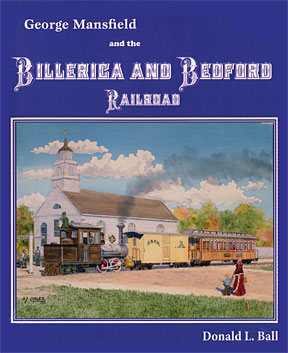
George Mansfield and the Billerica & Bedford Railroad
By Donald L. Ball -- Published in 2012
Hardcover: Text, Maps, Illustrations and Photographs
This is the definitive reference book for anyone who is interested in the history of the first two-foot-gauge railway in the United States.
When the Massachusetts towns of Bedford and Billerica clamored for a railroad, George E. Mansfield appeared on the scene and sold them on a new, inexpensive way to build one. He finished the line and it was acclaimed around the world as a brilliant new departure in railroad building. The Billerica & Bedford Railroad delivered everything its promoter said it would but, yet, it failed financially in less than a year. What happened to cause this failure?
Using original railroad documents and letters along with newspaper and trade journal articles, the author delves into the behind-the-scenes machinations that plagued this 8½ mile line. The backgrounds of the people involved are explored to determine their goals and motivations. Numerous drawings of the railroad rolling stock and structures are included along with examinations of the technical aspects of line which made it so revolutionary. George Mansfield went on to build the Sandy River Railroad as well as the Bridgton & Saco River Railroad, both of which survived into the 1930s and beyond. After only six years of railroad building, though, Mansfield seemingly vanished from the railroad scene without building another railroad. George did continue in railroading and rare documents and family photos show his later life along with his earlier lives and activities.
The technical features of this remarkable new gauge and railroad are covered in detail including the changes made by the Sandy River Railroad and subsequent owners. Original B&B brochures, corporate records and preliminary information drawn by George E. Mansfield are featured. This is the story of the pioneer two-footer which paved the way for the more successful narrow-gauge lines built in Maine and other locations around the country. It is also the story of the promoter of the Mansfield System of two-foot gauge railroads, who he was, where he came from and what happened to him and his dreams.
Today, the Billerica & Bedford Railroad’s Engine House survives as the ex-Boston & Maine Railroad Freight House in Bedford, Massachusetts, at the terminus of the Minuteman Bikeway.
This book is printed on heavyweight, glossy paper. It weighs over 2½ pounds.
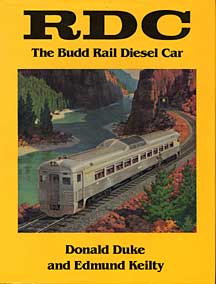
RDC: The Budd Rail Diesel Car
by Donald Duke and Edmund Keilty
Hardcover: 375 Photographs and Illustrations, 295 pages
This book chronicles, in word and picture, the history and development of the Budd Company's Rail Diesel Car, also known as the "RDC." The story evolves around a search for a self-contained, self-propelled railcar to reduce costs on suburban and branch rail lines. This book describes Budd's experiment with a stainless steel rubber-tired railcar, the first RDC prototype in the 1940s, the company's entry into the stainless steel railroad car business, and the birth and growth of the RDC. A vast appendix features every carrier that operated RDCs, a description of how the cars were used, route maps, and rosters of each railroad.
Anyone who is interested in the Boston & Maine RDC that is on display at Bedford Depot Park will appreciate this hefty book. The B&M once operated the largest fleet of RDCs in the world.
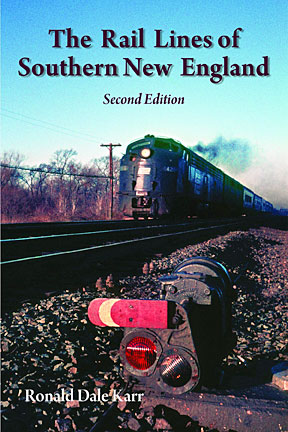
The Rail Lines of Southern New England:
Second Edition
by Ronald Dale Karr
Paperback, Text, Maps and Photographs, 452 Pages
Have you ever come across an active rail line or abandoned right-of-way and wondered where it goes, how it came to be, what kind if traffic it saw, or who owns or operates it today? Historian Ronald Dale Karr answers these questions for railfans and history buffs alike in this unique handbook. Each chapter comprises a lively, detailed chronicle of a rail line and its branches, a map showing the line's relationship to other lines, an all-time station list, and information about when the line was built, its operators, the number of passenger trains, and dates of abandonment.
With abundant photos and illustrations and a comprehensive index, this is a must for any New England "railfan."
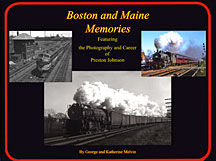
Boston and Maine Memories
Featuring the Photography and Career of Preston Johnson
By George and Katherine Melvin
Hardcover, Black & White and Color Photographs, 112 pages
Take a trip down memory lane as we guide you through the 45-year career of former Boston & Maine Railroad dispatcher Preston Johnson and present many of the memories and photographs of this lifelong railroad aficionado. Learn about the various B&M main and branch lines that Preston came to know so well, including the Lexington Branch to Bedford, Massachusetts.
This high quality book contains 230 photos of steam locomotoves, brand new Diesels, stations, towers and yards that are richly captioned with details about the railroad's operation and history. Preston's love for the old Boston & Maine emanates from each page.
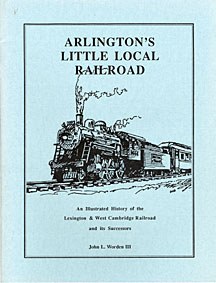
Arlington's Little Local Railroad:
An Illustrated History of the Lexington & West Cambridge Railroad and Its Successors
by John L. Worden III
8-1/2" by 11" Paperback, Text, Maps and Photographs, 26 Pages
This is an excellent overview of the history of the Lexington Branch of the Boston & Maine Railroad in Arlington, Lexington and Bedford. Today, this line between West Cambridge and Bedford, Massachusetts, is "rail banked" and used by the popular Minuteman Bikeway. The author has thoughtfully included route maps that show original track alignments and station locations. This is one of those reference books you'll keep as a permanent part of your rail history library. Model railroaders will appreciate this book for its track schematics, too.
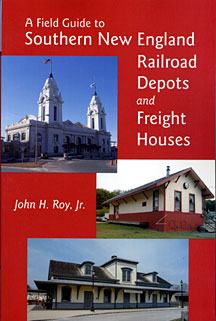
A Field Guide to Southern New England Railroad Depots and Freight Houses
By John H. Roy, Jr.
Softcover, 346 pages with photos
The author spent the last 15 years tracking down every station and freight house still in existence in Connecticut, Massachusetts and Rhode Island. This handbook provides a comprehensive guide to all 467 such structures that survive as of2007.
Each entry includes a photograph of the building, the date when it was built, its current use, and brief historical and architectural notes. "Railfans," modelers, architecture enthusiasts, local history buffs, and historical preservationists will find a wealth of information to help them explore New England's architectural and railroad heritage. Bedford Depot and Freight House are included in this book.
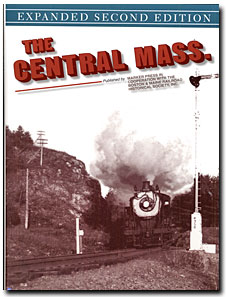
The Central Mass. - Expanded Second Edition
By Marker Press
Hardcover, Text and B&W Photographs, 177 pages
The Central Mass., first published by the Boston & Maine Railroad Historical Society in 1975, set forth the colorful history of the line from its beginnings as the Central Massachusetts Railroad until the publication date. This expanded second edition includes a reprint of the original plus 39 new pages about the subsequent fate of the branch line, its final days under B&M operation, and ongoing rebirth as a rail-trail. The supplement features 30 new illustrations and maps.
This book is a must-have for anyone who is interested in the history of the fabled B&M Central Massachusetts Branch!
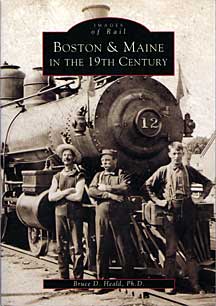
Boston & Maine in the 19th Century
by Bruce D. Heald, Ph.D.
Paperback, Text and Photographs, 128 Pages
All the romance of early railroading in northern New England pervades Boston & Maine in the 19th Century. This fascinating journey begins in the 1830s with an eight-mile line that just kept growing. By the end of the century, the Boston & Maine was traveling over 2,324 miles of track.
This first pictorial history of the Boston & Maine explores the heyday of an enterprising railroad. Using spectacular images, most of which have never before been published, the book takes us along scenic stretches of Massachusetts, New Hampshire, and Maine.
Through the generosity of the Boston & Maine Railroad Historical Society, the author was able to assemble this tribute to a transportation dynasty. Working with rare photographs and original documents from the Society's extensive archives, he has produced a work that is destined to please not only railroad enthusiasts but also residents of northeastern regions crossed by rail.
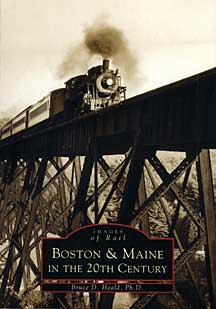
Boston & Maine in the 20th Century
by Bruce D. Heald, Ph.D.
Paperback, Text and Photographs, 128 Pages
As the 20th century dawned, the Boston & Maine Railroad Company controlled virtually all of the rail lines in New Hampshire, as well as much of the service in Maine and Massachusetts. Ultimately, the company operated more than 2,000 stations in northern New England. The train was the most important mode of travel, and the stations were the center of the community.
Boston & Maine in the 20th Century continues the first pictorial history of the company, Boston & Maine in the 19th Century. With more than 200 rare images and historical narrative, the book details the trains and their destinations: the terminals, stations, depots, and whistle stops to which they sped. Times changed, and the railroad was passed by; however, its legacy lives on.
To preserve and document the history of the region's transportation giant, the author worked extensively with the Boston & Maine Railroad Historical Society.
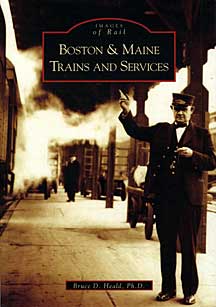
Boston & Maine Trains and Services
by Bruce D. Heald, Ph.D.
Paperback, Text and Photographs, 128 Pages
The Boston & Maine Railroad serviced most of New England as a primary mode of transportation during the 19th and 20th centuries. The birth of this railroad spurred the growth and development of industry in New England. This heritage is captured in Boston & Maine Trains and Services, the fourth volume in a series to focus on the history of this enterprising railroad.
The trains and services included in this book are the Pullman passenger cars, work trains with flatcars, boxcars, circus trains, plows, stock, cabooses, as well as the Boston & Maine bus service, trucks, and air service.
For this documentation of the American railroad, the author has assembled 200 rare images that celebrate the romance of the Boston & Maine's legacy. Special thanks are given to the Boston & Maine Railroad Historical Society for its generous assistance and support in preserving the history of New England railroading.
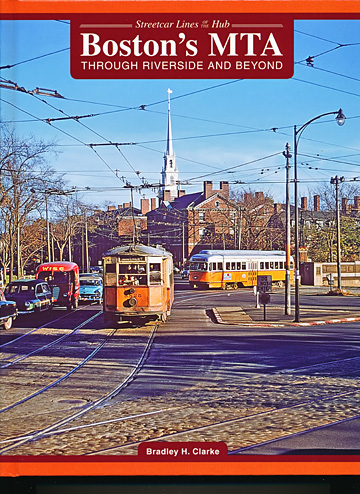
Boston's MTA: Through Riverside and Beyond
By Bradley H. Clarke, Boston Street Railway Association
234 pages, color photos and maps, hardcover
This second volume in the BSRA's "Streetcar Lines of the Hub" series continues the story of Boston street railways from 1950 to the end of the Metropolitan Transit Authority (MTA) in 1964. When the MTA succeeded the Boston Elevated Railway in 1947, high hopes were riding on its success. By the end of its last full year, however, the MTA's annual deficit had skyrocketed, and service had only expanded in two places: the Riverside Line to Newton and the East Boston Tunnel Extension to Revere. Where the MTA really succeeded—in terms of its goals—was the dismantling of most of Boston's remaining surface streetcar network. In 1940, there were 52 active streetcar lines, and by 1960, only 8.
In this new book, we take a nostalgic journey along the varied routes that the MTA's streetcar traversed. Witness changing equipment, memorable streetscapes and, for many lines, the final days of operaion with over 425 photos—most of which are in color—36 color maps and diagrams, and more color memorabilia! This is the only comprehensive book ever written about the streetcar lines of Boston's MTA. Included is an interesting chapter about streetcar service to Arlington Heights, Massachusetts.
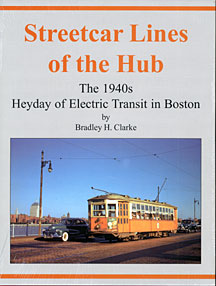
Streetcar Lines of the Hub
By Bradley H. Clarke
Hardcover, 216 pages
"The Heyday of Electric Transit in Boston"
Enjoy what may be the most detailed book ever written about Boston's streetcar lines! This definitive book contains nearly 500 photographs -- many in color -- plus maps and track diagrams.
During World War II, the Boston area's streetcar ridership hit record levels. The trolley's viability was reaffirmed one last time. This book covers all 52 routes, every car house and station, plus Eastern Massachusetts lines to Stoneham and Quincy. It's a must-have for anyone interested in the golden years of Boston's network of trolley lines.

